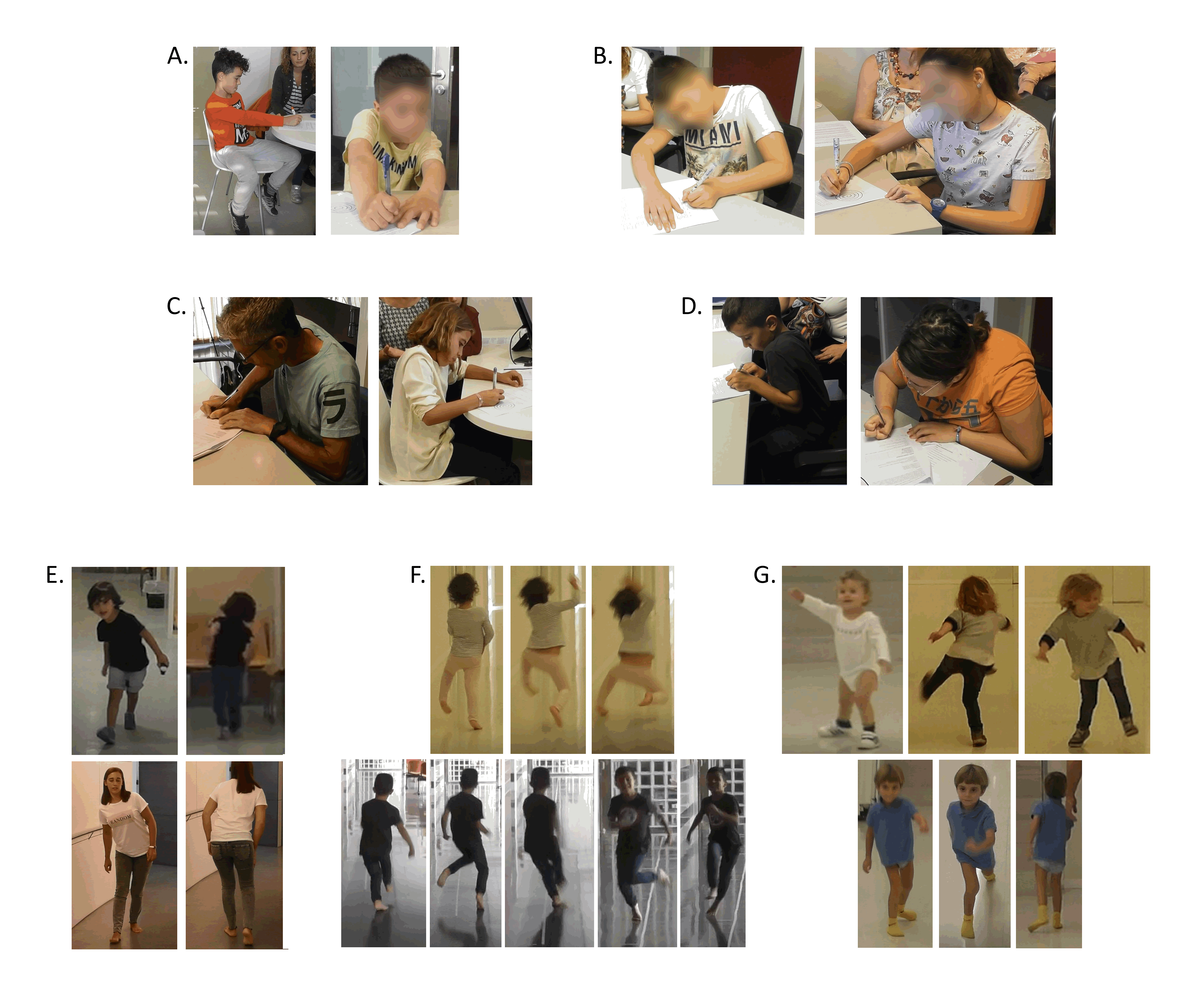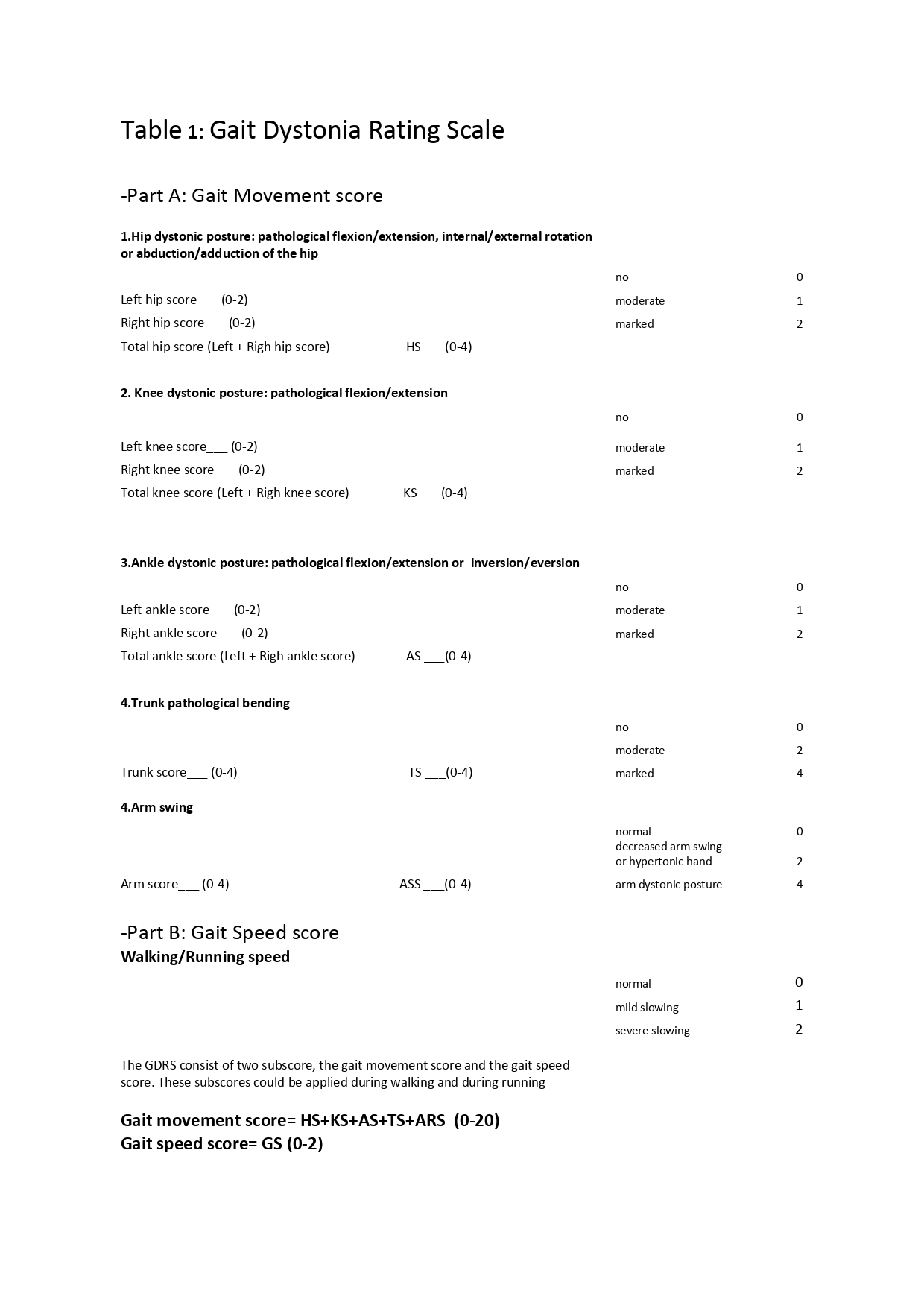Objective: The aim of this study was to analyze the clinical characteristics of dystonia (Axis I) and to explore rating tools for writing, walking and running dystonia in a large series of 49 SGCE-myoclonus dystonia (SGCE-MD) patients.
Background: Myoclonus-dystonia syndrome is a childhood onset movement disorder related to mutations in SGCE where dystonia is present in more than a half of cases
Method:
Cross-sectional analysis following a standardized videotaped examination protocol during rest, posture and specific actions for upper and lower limbs and of 49 SGCE patients (15.2±12 years) with action specific dystonia rating scales. Writing dystonia was assessed with the Writer’s Cramp Rating Scale (WCRS) in patients older than 5 year and gait dystonia was assessed using the newly developed Gait Dystonia Rating Scale (GDRS) (Table 1)
Results:
Writer’s cramp was a common (83%) and unique form of dystonia in one third of patients, affecting proximal (40%) and distal muscles (89%). Four writer’s cramp patterns were identified and three of them involved the shoulder (Figure1: A-D). Upper limb dystonia was uncommon during other actions (26%) and extremely rare at rest (2%). Walking (50%) and running (67%) dystonia manifested as “circular shaking leg”, “dragging-leg” and “hobby-horse ride” patterns (Figure1: E-G). Sensory tricks were used during writing (14%) and walking (34%) to improve dystonia and myoclonus suggesting common pathophysiological mechanisms for both movement disorders.
The writer’s cramp and gait dystonia rating scales had a 94% and 95,6% sensitivity in detecting dystonia. They correlated significantly with the speed of performing the task, self-reported disability and the Burke-Fahn-Marsden rating scale.
Conclusion:
Focal or segmental writer’s cramp involving elbow and shoulder was the most common form of action dystonia in our series, formed mostly by pediatric patients. Gait dystonia was also a very common dystonic feature in SGCE-MD patients and running increased dystonic gait severity. Early recognition of dystonic patterns and sensory tricks, and the use of action specific dystonia rating scales can help to identify and monitor therapeutic targets.
References: 1. Albanese A, Bhatia K, Bressman SB, et al. Phenomenology and classification of dystonia: a consensus update. Movement disorders : official journal of the Movement Disorder Society 2013;15;28(7):863-73. 2. Peall KJ, Kurian MA, Wardle M, et al. SGCE and myoclonus dystonia: motor characteristics, diagnostic criteria and clinical predictors of genotype. J Neurol 2014;261(12):2296-2304. 3. Nardocci N, Zorzi G, Barzaghi C, et al. Myoclonus-dystonia syndrome: clinical presentation, disease course, and genetic features in 11 families. Movement disorders : official journal of the Movement Disorder Society 2008;23(1):28-34. 4. Roze E, Apartis E, Clot F, et al. Myoclonus-dystonia: clinical and electrophysiologic pattern related to SGCE mutations. Neurology 2008;70(13):1010-1016. 5. Wissel J, Kabus C, Wenzel R, et al. Botulinum toxin in writer’s cramp: objective response evaluation in 31 patients. J Neurol Neurosurg Psychiatry 1996;61(2):172-5.
To cite this abstract in AMA style:
M. Correa-Vela, J. Carvalho, M. Vanegas, A. Cazurro-Gutiérrez, V. González, R. Alvárez, A. Marcé-Grau, A. Moreno, A. Macaya, B. Pérez-Dueñas. Analysis of dystonia and rating scales in children and young adults with SGCE myoclonus dystonia [abstract]. Mov Disord. 2021; 36 (suppl 1). https://www.mdsabstracts.org/abstract/analysis-of-dystonia-and-rating-scales-in-children-and-young-adults-with-sgce-myoclonus-dystonia/. Accessed December 13, 2025.« Back to MDS Virtual Congress 2021
MDS Abstracts - https://www.mdsabstracts.org/abstract/analysis-of-dystonia-and-rating-scales-in-children-and-young-adults-with-sgce-myoclonus-dystonia/


